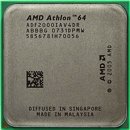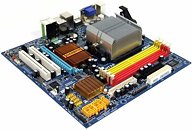- Joined
- Oct 9, 2007
- Messages
- 47,933 (7.37/day)
- Location
- Dublin, Ireland
| System Name | RBMK-1000 |
|---|---|
| Processor | AMD Ryzen 7 5700G |
| Motherboard | Gigabyte B550 AORUS Elite V2 |
| Cooling | DeepCool Gammax L240 V2 |
| Memory | 2x 16GB DDR4-3200 |
| Video Card(s) | Galax RTX 4070 Ti EX |
| Storage | Samsung 990 1TB |
| Display(s) | BenQ 1440p 60 Hz 27-inch |
| Case | Corsair Carbide 100R |
| Audio Device(s) | ASUS SupremeFX S1220A |
| Power Supply | Cooler Master MWE Gold 650W |
| Mouse | ASUS ROG Strix Impact |
| Keyboard | Gamdias Hermes E2 |
| Software | Windows 11 Pro |
While AMD touted the Bobcat as a definitive competitor to Intel Atom, being a low-power K8 based part with the same design advantages its ancestors had over competing Intel parts when they made up for higher performing alternatives, this part won't make it until next year, enough time for the Atom to gain a stronger foothold in the market. As immediate competition to the Atom, AMD seems to have set an Athlon 64 2000+ single core processor as its ULPC / UMPC processor part. This processor is single core, features a 1.00 GHz clock-speed and 256 KB of L2 cache, which should still give it a performance edge over a 1.50 GHz Atom judging purely by the fact that the Atom isn't based on the Core micro-architecture (yet) and uses an older design.
This processor is based on the Lima core, what's most surprising is that it is found to operate at 8 W at its 1.00 GHz frequency which brings it into the Atom platform's energy domain. The second most surprising point is that this processor will be aided by the powerful AMD 780G core logic (chipset), as opposed to current Atom platforms using a i945G adaptation that has significantly higher thermal envelope as opposed the AMD 780G while being a lot slower (in terms of graphics performance and features). Tom's Hardware conducted a comparison between the two and found that the Athlon-780G combo "knocks-out" Atom-i945G technologically.
The AMD 780G uses a fraction of the power i945G uses and makes up for several features the i945G lacks. The only drawback as of now is that AMD hasn't quite been able to reduce the board footprint of these parts. Despite having double the TDP to that of Atom, at 8 W, the Athlon chip still remained comfortable with passive cooling. This opens up a new round of competition, of that between Athlon and VIA Nano which claims to have higher levels of performance / watt over Intel Atom. The first picture shows the processor itself, the second one shows the processor seated on a AMD 780G based motherboard made by Gigabyte, where the processor is made to be cooled by the stock AMD AM2 cooler with the fan removed, to study the effects of passive cooling on the processor.


View at TechPowerUp Main Site
This processor is based on the Lima core, what's most surprising is that it is found to operate at 8 W at its 1.00 GHz frequency which brings it into the Atom platform's energy domain. The second most surprising point is that this processor will be aided by the powerful AMD 780G core logic (chipset), as opposed to current Atom platforms using a i945G adaptation that has significantly higher thermal envelope as opposed the AMD 780G while being a lot slower (in terms of graphics performance and features). Tom's Hardware conducted a comparison between the two and found that the Athlon-780G combo "knocks-out" Atom-i945G technologically.
The AMD 780G uses a fraction of the power i945G uses and makes up for several features the i945G lacks. The only drawback as of now is that AMD hasn't quite been able to reduce the board footprint of these parts. Despite having double the TDP to that of Atom, at 8 W, the Athlon chip still remained comfortable with passive cooling. This opens up a new round of competition, of that between Athlon and VIA Nano which claims to have higher levels of performance / watt over Intel Atom. The first picture shows the processor itself, the second one shows the processor seated on a AMD 780G based motherboard made by Gigabyte, where the processor is made to be cooled by the stock AMD AM2 cooler with the fan removed, to study the effects of passive cooling on the processor.


View at TechPowerUp Main Site
Last edited:







 That was too funny.
That was too funny.